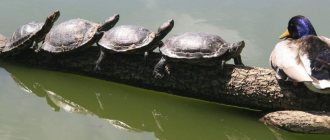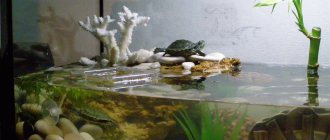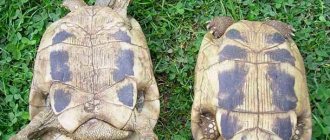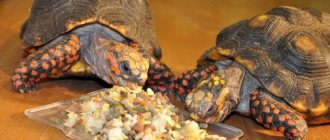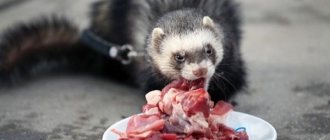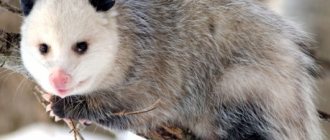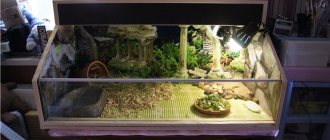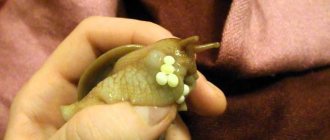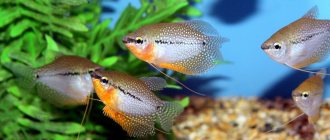Keeping small turtles
Regardless of whether the turtles are small or not, everyone needs care, and it is important to know which one is suitable for them and which is not.
When buying an aquarium for your future pet, you need to know that the water in it should be filled to a level of at least twenty centimeters. This height has long been calculated, since the peculiarity of these reptiles was noticed to walk at the bottom of the aquarium. For those who don't know, turtles don't have gills like fish, so they can't breathe underwater. It follows from this that, after walking along the bottom of its house, the turtle emerges to take a sip of oxygen. If there is more than twenty centimeters on the surface of the water, then it may simply not have time to do this, and will die from lack of oxygen. It is best to buy an aquarium with a larger area rather than a tall and narrow one. In the natural environment, turtles live in conditions where moisture and land are combined, and if the aquarium area is large, it can be equipped with both a dry zone and a sea zone.
As for nutrition, small turtles eat little; as food they prefer plants that grow in water; they can eat small fish and shellfish. If you want to feed your pet more sophisticated food, then special mixtures are sold that contain fish, shrimp and shellfish. In addition, you can please your little friend with pieces of beef that the turtle will like. As for greens, you can also supplement your pet’s standard diet with new dishes, give him lettuce leaves, or something green that will enrich the diet and benefit the reptile.
In addition to the above-mentioned species of turtles, there are also the following: red-eared, swamp, long-necked, and mud turtles. Silt is considered the most comfortable to keep, because it is the most unpretentious of all. This type of turtle spends most of its life in the aquatic environment; very rarely there come those moments when the turtle crawls onto land. This type of species requires a slightly smaller aquarium than other species. Fifty or seventy liters of housing will be enough for them. If you put soil on the bottom and plant some plants intended for growing in an aquarium, then these will be virtually ideal conditions for the mud turtle. If you do not have the time or opportunity to plant greenery, then place some object at the bottom in which the turtle can easily hide. This recommendation is already necessary. In case of any danger, the reptile must have a place where it can hide, otherwise it will not be comfortable for it to live with you.
It is worth paying close attention to the type of water your turtle swims in. The first condition is cleanliness, the water needs to be settled, or you need to choose special, purified water
The second important condition is the temperature of the water in which the turtle is located. The most comfortable range for her will be from twenty-two to twenty-five degrees
Each species has its own conditions under which they feel most comfortable living next to a person. If for undemanding reptiles just an aquarium and water in it is enough, then for more demanding species you also need a certain light, room temperature level, certain food products, regime and diet, which must be strictly maintained
There are species for which it is important that the room has clean air with a certain humidity
Each owner chooses a pet for himself and his capabilities. Some people enjoy working with a reptile, satisfying all its needs, but there are people who need to feed their pet once a week, and that should be enough. There are as many people as there are animals.
Small domestic aquatic turtles: gender, what to feed, photos, videos
The turtle needs love too
It is very important to understand that a turtle is a living creature that requires care and attention, and not a toy that can be played with and left to the mercy of fate. If you have chosen these unique reptiles, take a responsible approach to the question of what to feed your turtle at home.
After all, the health and life of your pet depends on it. The more seriously you take the conditions of its existence, the longer the turtle will be able to please you. When buying a turtle, contact experienced sellers who can tell you what to feed a water turtle at home and what to feed a land turtle, so that later you don’t have to guess why your pet died, because you fed it.
It turns out that if a turtle is not fed correctly, it begins to be capricious, eat poorly, or even refuse food altogether. or steppe turtles are no exception. In order for your pet to feel at ease, properly structure your baby’s diet.
What to feed the Central Asian land turtle?
Let's start with the fact that absolutely all turtles love plant foods. Healthy plants include cabbage, pumpkin, watermelon, melon, lettuce, apples and dandelions. They will not refuse berries - raspberries, cherries and strawberries. Milk with white bread soaked in it will also appeal to the armored animal.
What else is possible? Calcium is necessary for building and maintaining the strength of the bone cover - the shell. Therefore, fresh cottage cheese must be present on the menu. Semolina and buckwheat porridge will usefully enrich the list of food products.
Don't think that turtles are vegetarians. They eat absolutely everything. Therefore, you need to be very careful when decorating terrariums. After all, almost everything that gets there will be “tested.” So, do not deprive your pet of protein food. One tablespoon of raw minced meat or half a hard-boiled egg is enough. But instead of feeding a domestic land turtle with meat that is harmful to it, make up for the lack of protein by replacing the product that is bad for the kidneys with a real worm, which is fed to aquarium fish. But don't overdo it. Any food of animal origin can lead to indigestion. It’s better to replenish your turtle’s kitchen with beans rich in vegetable protein.
Do not overfill your turtle's diet with tomatoes, cucumbers and carrots. They don't like them. This is easily explained, because in the wild these animals eat berries, desert plants or carrion.
What to feed a land turtle in winter?
Turtles usually hibernate during the winter. But the house is quite warm during this cold period. Therefore, the turtle does not sleep, but simply becomes slow. What should you feed your land turtle at home during this period?
Food products can be left the same. But don't be surprised if your little friend can't make it through the summer daily quota. An approximate daily diet can be calculated for the winter period, and it will look something like this:
- carrots – 30 grams,
- boiled potatoes – 20 grams,
- cabbage – 30 grams,
- white bread – 20 grams,
- fish oil – 0.5 grams,
- beets – 20 grams.
Just don’t forget to enrich this list with herbs in the summer, for example, dandelion, the leaves of which can be picked far from a busy and polluted highway and city.
Does a land turtle need to be given water?
We told you what to feed domestic land turtles. But, after all, they also need water, although they drink quite rarely: some drink it once every one to two weeks, while for others, one “date” with water per month is enough. The frequency with which water treatments need to be administered depends on what the animal eats over a certain period of time. If it is cabbage, then the cells of the turtle’s body receive a sufficient amount of moisture, and you will have to “bathe” less often. But if the majority of the daily diet consists of white bread, baths should be arranged a little more often.
Although, in order not to rack your brains, give your turtle a bath day once a week or a week and a half. Pour a little less than a centimeter of water into the basin. The pet's nose must be above the water level so that the land inhabitant of our planet does not suffocate. Place the animal in the water and leave it to enjoy for half an hour. Believe me, this time is enough for the baby to have time to get drunk and take a swim.
Unfortunately, many people do not take turtles seriously enough, not like other pets, they know little about the peculiarities of keeping and caring for them, and most importantly, they have little interest in the question of what to feed turtles. But these babies also require a balanced diet, various nutritional supplements for active growth and well-being.
How to find out age
Unfortunately, sometimes even store salespeople are unable to accurately tell the age of a red-eared turtle, so owners have to deal with this issue on their own. The following data will help you find out the age of a reptile:
- 2 years – females 8-9 cm, males – 7-8 cm.
- 3 years – females 10-14 cm, males – 8-10 cm.
- 4 years – females 13-16 cm, males – 12-14 cm.
In addition to calculating age based on pet size, you can find out the approximate number of years in the following way:
- Shell color - in young turtles the coating is green. After 4 years of life, the shell begins to darken; in older reptiles the cover is almost black.
- Rings – rings are formed on the shell when reptiles reach one year, 2-3 rings are added every six months. After 4 years of life, the ring appears once a year. By counting the number of rings, you can roughly estimate the age of the turtle.
How to choose a land turtle
For home breeding, Central Asian (steppe) individuals are chosen. They are small in size - up to 20 cm long. The color of the shell of a young individual is yellow with round brown spots. Pay attention to activity. The turtle is awake in the morning and evening, and rests in a shelter during the day and night. The animal must look healthy and have no skin defects.
How to determine gender
Main gender differences:
- The shape of the shell is more elongated in the male.
- Plastron (lower part of the shell) - in the male, near the tail, it has a concave shape, which ensures mating. In females, the plastron is straight, which is necessary for bearing eggs.
- Male turtles have a V-shaped notch on the top of their shell near the tail.
Pet diseases
If kept and fed improperly, pet turtles often get sick. The most common illness that afflicts reptiles in an aquarium is pneumonia. It occurs as a result of hypothermia. It is necessary to ensure that the animal’s water is at least twenty-eight degrees. The first signs of the disease are:
- loss of appetite;
- lethargy;
- inability to dive under water.
Treatment for your pet should include providing warmth. To do this, it is necessary to monitor the temperature of the water in the aquarium, the lamp above the land must be constantly on, and the turtle itself must be kept in the warm steam of chamomile decoction two or three times a day.
Reptiles can also catch an infectious eye disease. The turtle's eyes become inflamed and the eyelids swell. With such symptoms, she is isolated from other animals and kept exclusively on land, and is put into water only for an hour or two a day. They treat inflammation with antibiotics for the eyes, instilling them three times a day.
If the turtle's shell has become soft and has begun to lose its shape, then it is necessary to provide proper balanced nutrition and add vitamin supplements to the diet. Plus, most likely the animal does not get enough ultraviolet radiation. Therefore, in the summer, the reptile should be taken outside, and at other times, do not forget about ultraviolet lamps. Also, if the food is insufficiently nutritious, the animal’s skin may peel off.
If you follow the basic rules for keeping turtles in aquariums, reptiles will become beloved pets for a long time.
Food
The favorite food of ordinary musk turtles is small fish, aquatic insects, mollusks, shrimp, algae; these reptiles do not disdain a variety of carrion, for which they have earned a reputation as orderlies of reservoirs.
If a musk turtle lives in a home terrarium, then, given its taste preferences, there is a high probability of contamination of the water with food debris, so for feeding it is recommended to use tweezers or special needles adapted for threading food. Most likely, the turtle will not immediately understand the purpose of such devices, but if you wave a tasty piece of meat in front of its nose, it will get used to it quite quickly. Mobile young individuals can begin hunting for small fish kept in the same aquaterarium, for example, guppies.
Types of small turtles
A small turtle can be represented by the following species:
Flat-bodied turtles, or as they are also called, flat turtles. These turtles grow up to six centimeters in length, but sometimes there are individuals that reach eight and a half centimeters. As for their weight, it ranges from one hundred to one hundred and seventy grams. Due to the fact that the animals have very small dimensions, it is easy for him to swim in any aquarium, even a small one. Flat turtles use succulents as food, those plants that contain a lot of moisture. Flathead turtles are not the easiest to care for; there are a number of requirements that must be met for the animal to live normally in captivity. A characteristic feature of this species is that these reptiles have weak immunity and can easily catch any viral disease. Due to this feature, they should be kept separately from other species.
In order to carry out the reproduction process of flat turtles, it is necessary to create conditions for hibernation of the reptiles. This is only possible if the water temperature is at the desired level
The importance of hibernation lies in the fact that after it, males become active and show their interest in females, and without this long sleep, these processes do not occur. Winter sleep lasts about two months, and the water temperature should be reduced to plus ten degrees
As for the food that these turtles prefer, it is plant foods. The water temperature for them is normal if it fluctuates between fifteen and eighteen degrees Celsius. It is better to place small stones at the bottom of the aquarium; their layer should not be thicker than two centimeters.
Locked turtles are a species of animals that live only in a certain area, namely Mexico, the United States, and Africa. Among this species, four more subspecies can be distinguished. The small turtle of the yellow captive subspecies has many similarities with the reptile of the Sonoran captive subspecies, because both animals grow up to seven and a half centimeters, although reptiles reaching sizes of thirteen centimeters are frequent exceptions. As for the other two turtle species, they are the banded turtle and the reddish mud turtle. The dimensions of these subspecies are a little more modest; they usually grow from seven and a half to eleven centimeters.
Musk turtles are also small turtles, but their size is slightly larger than other species. A small turtle of this species grows from seven and a half to fifteen centimeters. These reptiles also have four subspecies: keeled musk turtles, which grow from seven and a half to fifteen centimeters, the common musk turtle, as well as the small musk turtle, have sizes from seven and a half to twelve and a half centimeters. The next species is called Sternotherus depressus, of all the subspecies, they grow the smallest, from seven and a half to eleven centimeters.
Spotted turtles are a species that are semi-aquatic. In terms of size, this small turtle has average dimensions, from seven and a half to thirteen centimeters. In addition to the usual aquarium with water, this species requires another, but already dry, aquarium. A peculiarity of the species is that spotted turtles eat not only plant food, but also animal food. They need to be given aquatic insects, tadpoles, worms of various origins, and small crustaceans. Not every owner is able to constantly find this kind of food and feed it to the turtle, so before getting this variety, you should think about it.
Chinese three-keeled turtles are reptiles with an average body size of thirteen centimeters. As for the characteristics, among all the species, this turtle has the calmest character and is the most unpretentious. This is why three-keeled turtles are recommended for those who are encountering this kind of animal for the first time.
These Chinese reptiles only need to be provided with a water aquarium of about one hundred to one hundred and fifty liters, and this will satisfy their most basic needs. As for food, reptiles love to eat; they enjoy foods of both plant and animal origin. If you are not sure that you are feeding your reptile everything it needs, then it is better to give it vitamins as well. Chinese three-keeled turtles are quite hardy in terms of temperature changes in their water space. They will easily survive a change in temperature from twelve degrees to thirty. Despite such stability, it is still not recommended to set such extreme tasks for the animal.
DIY turtle food
A very common and easy-to-make treat for pet turtles is a food mixture based on vegetable agar-agar or food gelatin of animal origin.
Such food can not only completely solve the issue of adequately feeding a turtle, but also allows you to make your pet’s diet as varied, nutritious and healthy as possible.
To prepare, you need to purchase the main ingredients presented:
- cabbage – 50g;
- apples – 50g;
- carrots – 50g;
- sea fish – 145g;
- a couple of raw eggs;
- raw squid – 100g;
- powdered milk – 150g;
- gelatin – 30g;
- clean drinking water – 150ml;
- “Tetravit” – 20 drops;
- “Calcium glycerophosphate” – 10 tablets.
Gelatin should be dissolved in water, which will provide the basis for a nutritional mixture, to which all of the above ingredients must be added, as well as crushed Calcium Glycerophosphate and Tetravit tablets.
Important! Pre-grind all components in a meat grinder or blender, then mix thoroughly.
The finished nutritional mixture must be stored in the refrigerator . Before giving it to the animal, such food is cut into small cubes and warmed at room temperature. This amount of ingredients is designed to prepare ten full servings for feeding an adult.
Return to content
Species of red-eared turtles
The popularity of yellow-bellied reptiles was given not only by their attractive appearance and easy care, but also by the variety of subspecies. Among the species of red-eared turtles, the following representatives are especially in demand:
Trachemys scripta scripta – the turtles reach 27 cm in length and have a characteristic lemon spot that merges with the stripe on the neck. The plastron is yellow with spots.
Trachemys scripta elegans - grows up to 28 cm. There is a wide red stripe on the head of reptiles.
Trachemys scripta troostii - representatives stretch up to 21 cm. There is a yellow stripe and extensive chin lines on the head. There is a yellow line on each costal shield. The plastron is decorated with small black spots.
Interesting facts about red-eared turtles
Red-eared slider photo
– Today, the red-eared turtle is one of the most popular inhabitants of the home aquarium. In European countries, promotions are regularly held that urge lovers not to purchase these turtles, because their population is rapidly declining. In Switzerland, a special center has even been created where you can bring a grown turtle.
– Turtles have lived on earth for almost 200 million years; they appeared long before birds, crocodiles, mammals and even lizards.
– In Russia, freshwater turtles with a characteristic red spot on the head are called red-eared, and in Germany – red-cheeked.
– Red-eared turtles have a well-developed sense of smell, vision and touch, and their shell contains a large number of nerve endings.
– The lifespan of red-eared turtles is 30 (40–45) years, European marsh turtles are the same, sometimes even 80 years.
– Fishermen look for clutches and use turtle eggs as excellent bait for fish.
– Young turtles are captured in untold quantities (especially in the Mississippi Valley) and transported to pet stores throughout the United States.
– Turtles are often aggressive and can bite both people and other turtles. Red-eared turtles, accustomed to being handled, often do not bite.
– And in some Asian countries it is customary to release turtles into the wild environment as part of the tradition of the Buddhist ceremony of mercy to increase positive karma, respect for the Buddha and repentance for sins.
Author Alexander Isakov
What to feed a red-eared turtle at home?
Feeding the red-eared turtle does not cause any particular difficulties; this type of reptile is omnivorous; the main thing is to provide it with a balanced diet, in which up to 70% are animal products. Like most predators, the reptile should also be fed plant foods, which will help fill the body with vitamins and microelements. From it the turtle receives calcium for the development of a strong and healthy shell. The diet of red-eared turtles living in an aquarium consists of the following components:
- Animal feed - meat, fish and seafood, insects, snails, worms, caterpillars.
- Plant foods - grass, fruits and berries (seedless), vegetables, mushrooms, aquarium plants.
- Artificial feed - purchased, dry, balanced mixtures.
How to feed a red-eared turtle with dry food?
Often, reptile owners, when thinking about what to feed red-eared turtles, prefer dry food, sold in pet stores in the form of granules, tablets, capsules or flakes made from dried crustaceans. It should be borne in mind that dry food can be used infrequently, adding to the main diet in the form of a treat.
If you decide to feed your red-eared turtle dry food, you can dilute it with small meat or fish pieces, add algae or other plant products. Do not accustom your pet to one type of dry food; periodically change its composition and manufacturer, choosing well-known, proven brands
Pay attention to the purpose of dry food, some of its types are used as main food, some - in the form of an energy supplement, as a prevention against rickets or to maintain immunity
What fish should you feed your red-eared slider?
Quite rightly, some owners raise the question of what kind of fish can be fed to red-eared turtles. Not every type of fish is suitable for use in the diet of these reptiles. It is better to feed the red-eared turtle with freshwater species of fish, they are less fatty, but you can also give them sea fish - after soaking it in water and boiling it.
Before feeding your red-eared turtle fish, remove large bones from it and cut into small pieces. Red-eared turtles will not refuse seafood: mussels, shrimp, squid, crabs - they are bought fresh or frozen in the store. To prevent parasites from entering the body of reptiles, it is better to lightly boil fish and seafood or at least pour boiling water over them.
What kind of meat should I feed my red-eared slider?
When feeding turtles, give preference to lean meats:
- beef;
- horse meat;
- rabbit meat;
- lean lamb;
- offal.
To the question whether it is possible to feed a red-eared turtle chicken, the answer is unequivocal - it is possible, especially chicken liver. By giving liver to reptiles once every 7-10 days, you don’t have to worry about a lack of vitamins. The types of meat should be changed periodically, since the protein content in different types is different. It is even better to alternate meat food with fish food, this will eliminate the possibility of rickets.
What vegetables can you feed your red-eared slider?
Let's consider what you can feed a red-eared turtle besides food, meat and fish. Plant crops, especially vegetables, diversify the reptile menu. The more varied you feed your red-eared turtle with vegetables, the more different microelements and vitamins it will receive. The best vegetables are:
- zucchini, eggplant;
- tomatoes;
- carrots and beets;
- Bell pepper;
- cabbage.
When adding vegetables to the food of red-eared turtles, do not overdo it with any one type, it is better to use a little of everything. Vegetables do not contain protein, so they do not contribute to the intensive growth of reptiles; it is better to include them in the diet for older turtles. Do not feed spoiled or spoiled food to animals; this will cause them distress and poisoning.
Products prohibited for turtles
There are many foods that are strictly prohibited for turtles. These include:
- plants (poisonous) belonging to the nightshade family, ranunculaceae, as well as medicinal plants containing alkaloids;
- peel of all citrus fruits;
- seeds of berries and fruits;
- radishes and radishes;
- dry and wet factory food for other pets;
- bread, dairy products;
- all food that has undergone heat treatment (with the exception of boiled egg yolk and chicken breast);
- indoor and ornamental plants: dieffenbachia, rhododendron, violet, jasmine, crocuses, daffodils, etc.
Benefits of keeping baby turtles
Many people dream of having some kind of exotic animal live in their home. It is worth noting that in some apartments you can find pythons, lizards, snakes, etc. Unfortunately, most apartments are not large enough to accommodate a crocodile, for example. Although rare, such an animal can be found.
As for the turtle, this is what is needed. Firstly, this is a completely harmless animal that will not harm anyone, including children, and secondly, a small turtle takes up very little living space. And feeding a small animal is always much easier. In addition, caring for such a pet can be entrusted to a teenager. He will not only become familiar with the living conditions of this animal and its habits, but will also learn to love nature in general, and not just pet turtles.
Three groups of turtles
Based on their feeding type, turtles are divided into three groups: carnivores, omnivores and herbivores.
. Each of them corresponds to a certain ratio of animal and plant foods. Feeding inappropriate food for each group of turtles is fraught with diseases of the internal organs, digestive complications, and metabolic problems. You also need to include calcium and vitamins in your diet weekly. What food should be given to each group?
Predatory
The food of predatory turtles should consist of 80% animal food and 20% plant food. This group includes almost all aquatic species and all young aquatic ones, such as young red-eared, caiman, trionics, swamp, musky, etc.
The main food for them is:
- lean fish, live or thawed, with entrails and small bones. For young turtles, the fish should be finely chopped (spine, excluding ribs) with bones, for adults - whole or large pieces. Large bones can be ground or finely chopped.
- beef or chicken liver is given once a week;
- seafood such as green (not pink) shrimp, sea cocktail;
- mammals (small): naked mice, rat pups, runners.
The turtle can eat all seafood, as well as fish, only raw; heat-treated food should not be given;
Additional food
, which should be given once a week, serves:
- Dry food for freshwater turtles, for example, in the form of sticks, tablets, flakes, granules, capsules, Sulfur, etc.
- Insects: moth, food cockroaches, grasshoppers, bloodworms, crickets, earthworms, gammarus and so on;
- Mollusks, amphibians, invertebrates: slugs, frogs, small snails with shells, tadpoles and similar swamps.
It is prohibited to give to predatory turtles:
meat (beef, chicken, pork, lamb, sausages, sausage, any type of minced meat, etc.), as well as fatty fish, milk, cheese, bread, fruit, dog or cat food, etc.
The diet of this group of turtles should consist of 50 percent animal food
and 50 – vegetable. Omnivorous turtles include semi-aquatic and adult aquatic turtles, some types of land turtles: spiny turtles, coora turtles, adult red-eared turtles, Spengler's turtles, red-footed turtles (coal turtles), etc.
Their menu consists of half animal food, see the list above, and half plant food, the list is below. Aquatic turtles are pampered with fish
and seafood (as animal food), and mice are given to land animals.
- Plant food for aquatic species are plants growing in water conditions,
- Land animals are given plants that live on the ground, and fruits and vegetables are added to them.
Herbivores
The menu of this group of turtles is based on plant foods, which make up 95% of the total diet, animal food consists of 5%.
Herbivores include: all land turtles, including radiated, flat, Central Asian, Greek, spider and others.
The main food of this group is:
- greens, it makes up 80% of the entire menu (semi-dry or fresh salads, edible leaves, flowers, succulents, herbs.
- vegetables - 15% of the diet (pumpkin, cucumbers, zucchini, carrots...)
- fruits that are not very sweet (apples, pears, etc.) are represented in 5% of the menu.
Additional food
once a week, it includes:
- non-poisonous mushrooms, such as russula, boletus, champignons, etc.
- dry balanced food for land turtles of the brands “Sera”, “Tetra”, “Zumed”.
- other: soybean meal, dry yeast, raw young sunflower seeds, bran, dried seaweed...
It is prohibited to give meat; this category includes: any minced meat, sausages, sausage, chicken, beef, pork, etc.). Also fish, milk, cheese, cat or dog food, bread...
Caring for Aquatic Turtles
The shell of an aquatic turtle needs to be regularly cleaned of algae growth.
Cleaning must be done carefully to avoid damaging the turtle's shell.
You should not keep your reptile in water all the time; this can be harmful to its health. The turtle also needs to stay on land.
The water temperature in the aquarium should not exceed 21 degrees. The aquarium can be illuminated with simple or ultraviolet lamps.
The turtle is fed food of plant and animal origin. To avoid diseases, food should be varied. Young turtles are fed daily, starting from the age of 3 - three times a week.
Water turtles are afraid of the cold. In winter, to warm them, you need to use a special ultraviolet lamp. The animal must be warmed up three times a week. In summer, you can place the aquarium in fresh air, but make sure that it is not exposed to direct sunlight.
Rules for feeding pet turtles
Pets are fed at approximately the same time, so they get used to it and expect food. It is important to provide enough food, but not to overfeed. Young individuals (up to 2 years old) eat daily, and older ones - once every 2 days.
At the same time, you cannot give food from your hands; it must be placed in the feeder for land reptiles and in the water for amphibious reptiles. Otherwise, pets will get used to it and will not eat from the bowl.
Remains of food are removed from the terrarium or aquarium. Otherwise, they may spoil, and eating them will lead to poisoning of the turtles.
In autumn and winter, the amount of food is slightly reduced, since the activity of reptiles decreases, but vitamin complexes and supplements are added. The veterinarian will tell you which ones are best to give and their quantity.
Variety of choices
The usual length of small turtles is from seven to thirteen centimeters. When buying a water baby about five centimeters, you need to understand in advance that it may increase slightly in size over time. Several types of turtles are well suited for quickly adapting to home keeping.
Musk (Sternoterus)
It is a representative of the genus of mud turtles, and the smallest specimen. Its length does not exceed fourteen centimeters, and the average size of the shell is seven centimeters.
A special feature of the musk turtle's structure is its long neck. She can easily reach her hind legs with her jaw. Its carapace is smooth, but at an early age there are three clearly visible grooves on it. The turtle has a dark, uniform color, only light stripes are present on the head.
This turtle has a long neck
In its natural environment, this waterfowl lives in the south and east of the United States, and much less often in Canada. Small reptiles prefer freshwater bodies of water with muddy bottoms. They spend most of their lives in water.
Spotted (Clemmys guttata)
A fairly common species of turtle among exotic lovers. Domestic aquatic little beauties are recognizable by yellow spots located along the entire plane of the carapace - the dorsal shield of the turtle shell. Such spots are also present on the head, neck and paws.
This species can reach a length of no more than twelve centimeters. The neck of this turtle is quite short. Spotted turtles have a creamy-yellow ventral shield (plastron) with large black spots over the entire area.
In their natural environment, these creatures live almost throughout the Atlantic coast of the United States. Rarely found in Canada. In living conditions, they prefer swamps, small rivers with silted bottoms, and swampy wooded areas. They overwinter on the muddy bottom of reservoirs.
12 cm is the maximum height of this turtle
Flat (Platemys platycephala)
It is a species of the snake-necked turtle family, as well as the only representative of the species of flat turtles. The usual body length is 14-15 centimeters, rare specimens reach eighteen.
This cute version of small aquarium turtles features an orange and yellow head pattern that resembles a crown. The carapace in babies is dark brown with a yellow edging, and the plastron is yellow. This color scheme often plays a decisive role in deciding whether to keep this species at home.
The only species of the genus flat turtles, which previously also included some other species of the family.
The turtle has a long neck with small spines. The dark tail and paws contrast beautifully with the variegated color of the smooth and somewhat flattened shell. The chin is decorated with a cute mustache.
This species often lives at home due to its bright appearance and calm nature. Flat turtles can be kept several times in one aquarium. The calm environment can only be disturbed by males during the mating season.
Reeves pond turtle
This species (Chinemys reevesii) is often found in domestic pet stores. The length of the oval-shaped shell in adults does not exceed thirteen centimeters, so they can be kept in an aquarium without any problems.
The carapace of the Reeves pond turtle can be of different colors: yellow-brown, dark brown, black. The legs and neck are usually black, gray-green or olive in color with white or yellow lines on the sides.
This species of small pet turtles has a peaceful nature. It is allowed to keep several specimens in one aquarium. The pond turtle is diurnal and can provide many funny moments to its owners. It tames very quickly, each specimen has an individual character.
These turtles are peaceful
The Reeves pond turtle is native to China and Japan, and less commonly found in Taiwan and Korea. Natural habitats include ponds and streams. In sunny times, Reeves likes to crawl out onto clay and sandbanks.
Features of feeding by season
Despite the fact that at home turtles practically do not feel the change of seasons, by winter they become less active. Owners of an exotic pet should remember that it is better not to let it hibernate - it requires special care, and in the spring the animal may not wake up.
As activity decreases, the amount of food consumed also decreases. However, the menu should remain as varied as possible. During this period, seasonal vegetables will be useful for turtles - cabbage, beets, carrots, as well as raw meat and boiled eggs. All products are consumed in moderation.
In addition, calcium supplements continue to be given, and special multivitamins are given to prevent diseases.
If there are doubts about the balance of the home diet, you can switch the animal to ready-made food.
